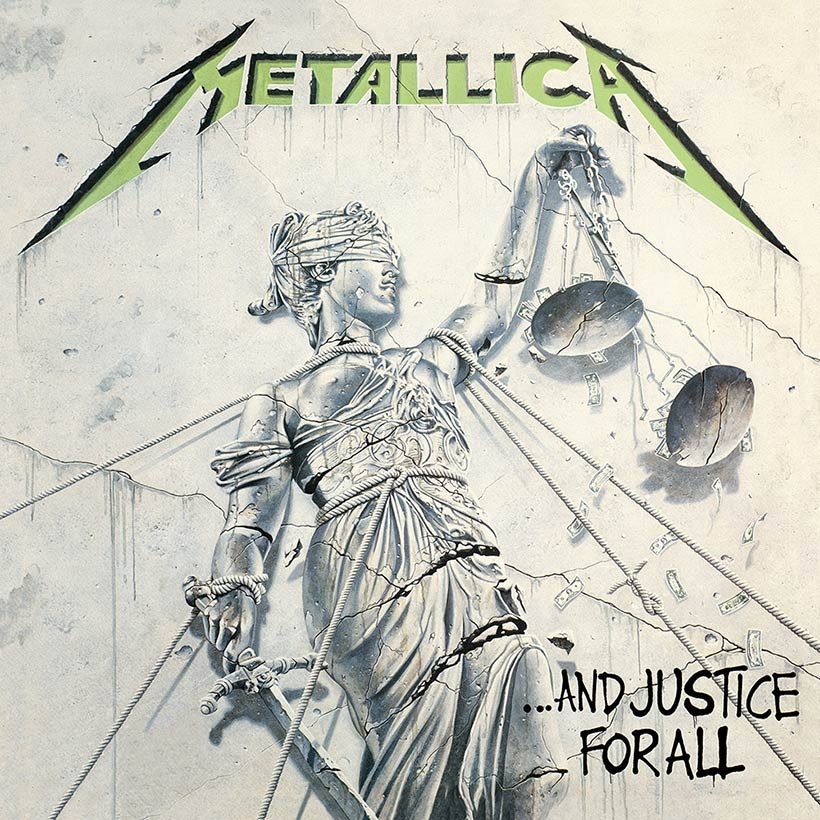‘… And Justice For All’: How Metallica Won The Verdict And Went Mainstream
With ‘… And Justice For All’, Metallica created a complex, powerful work, opening a door to a world it’s now impossible to imagine without them.

Metallica have never been afraid to follow their own path. From debut album Kill ’Em All through to fourth album … And Justice For All they dared to push the frenetic limits of thrash metal. In the process, they set the blueprint for what would become speed metal; shocked everyone with the acoustic intro to second album, Ride The Lightning, and the casual inclusion of the balladic “Fade To Black;” and attracted major-label budgets and a big-time management company with 1986’s Master Of Puppets. All the while, the group exhibited the guts to experiment with song structures.
Listen to … And Justice For All.
For Master Of Puppets the thrash titans displayed a more controlled approach to songwriting, partly due to bassist Cliff Burton’s classical training; the realization came that sounding as heavy as a sack of bricks didn’t necessarily mean playing at breakneck speed. During extensive touring in support of the album, however, Burton was tragically killed in a bus crash after a show in Stockholm, on September 26. It was a devastation that could have finished the group.
Metallica, however, believed the late bassist would have wanted them to carry on, and, with his family’s blessing, the San Francisco-based thrashers vowed to honor his legacy. A little over a month later – but not without 40 or more auditions – the band settled on Jason Newsted from little-known Phoenix, Arizona, thrashers Flotsam And Jetsam as their new bassist. His live debut came at the Country Club in Reseda, California, on November 8, 1986, while his first recording session bore the covers collection The $5.98 EP: Garage Days Re-Revisited. But Metallica’s next studio album would be the real test as to whether they could overcome the loss of the creative force and commanding presence that was Cliff Burton.
And so, on September 5, 1988, came … And Justice For All. The title itself is taken from the US Pledge Of Allegiance, so it’s unsurprising that, thematically, the album explores the concepts of justice and freedom through the themes of war and politics. Opening track ‘Blackened’ sets out the stall in the no-messing-around way Metallica had kicked off each previous album. Credited in part to Newsted, it cemented the bassist firmly in Metallica’s ranks.
On the title track, the Bay Area thrashers pushed unconventional song structures and arrangements to the extreme. The near-ten-minute epic builds from a gentle twin-guitar intro into an explosion of militaristic-style riffs, twisting and turning at will with short, sharp shocks of thrash flourishes and even Thin Lizzy-influenced guitar harmonies. Just when you think the song has settled into its stride it turns on its heel and casually throws the listener an unexpected curveball, setting a standard that continues through the likes of “Eye Of The Beholder” and “Frayed Ends Of Sanity.” The metal titans clearly weren’t chasing radio airplay with their fourth-long player; only one track clocked in under six minutes.
It’s ironic, then, that in the album’s third single, “One,” Metallica earned their first worldwide hit, claiming a Top 40 spot on the Billboard charts and breaking the Top 20 in the UK and Top 5 elsewhere in Europe. An anti-war song, “One” depicts a fallen war hero made quadriplegic, blind, deaf, and mute by a landmine, and is based on the Dalton Trumbo-directed movie Johnny Got His Gun. It was accompanied by Metallica’s first foray into music videos, which featured clips from the film after the band bought the rights to it.
If you were starting to think that they’d forgotten how to play heavy, “The Shortest Straw”’s bludgeoning opening riff is a stark reminder that no one does heavy quite like Metallica in this thrash metal maelstrom. And if there was a danger of over-complicated song structures taking over, they’re pared right back on “Harvester Of Sorrow,” which displays a new dimension of heaviness in its relative simplicity, effectively maintaining one riff and form throughout. “To Live Is To Die,” meanwhile, was created as a tribute to the late Cliff Burton and features basslines recorded before the musician’s untimely death. Then the whole epically creative opus draws to a frenetic conclusion with “Dyers Eve.”
… And Justice For All peaked at No.6 on the Billboard album chart and achieved platinum status two months later. After lingering on the charts for a mammoth 83 weeks, the album would earn Metallica their first Grammy nomination for Best Metal Performance – which they famously lost to Jethro Tull. And yet, where … And Justice For All may once have never been made at all, Metallica created an album that opened the door to a world it’s now impossible to imagine without them.












